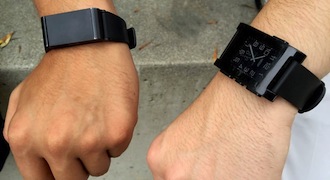Wearables
JPL/UCLA Wi-Fi Reflector Chip Reduces Battery Use on Wearables
- By Dian Schaffhauser
- 08/13/15
 The more a wearable transmits the data it collects, the shorter the battery life powering the shuttle of information from the device to a
computer, cellular or Wi-Fi network. Two scientists at NASA's Jet Propulsion
Laboratory (JPL) and the University of California, Los Angeles, have developed a chip
intended to make the power needed to send data negligible, enabling the wearable to run longer without recharging.
The more a wearable transmits the data it collects, the shorter the battery life powering the shuttle of information from the device to a
computer, cellular or Wi-Fi network. Two scientists at NASA's Jet Propulsion
Laboratory (JPL) and the University of California, Los Angeles, have developed a chip
intended to make the power needed to send data negligible, enabling the wearable to run longer without recharging.
Adrian Tang of NASA's JPL and M.C. Frank Chang at UCLA have developed microchips for wearables that reflect wireless signals instead of
using regular transmitters and receivers. In testing, the approach transmits data up to three times faster than regular Wi-Fi.
"The idea is if the wearable device only needs to reflect the Wi-Fi signal from a router or cell tower, instead of generate it, the power
consumption can go way down [and the battery life can go way up]," said Tang in a prepared statement.
The chip design takes advantage of the fact that data is encoded as 1s and 0s, just like data on a computer. When incoming energy is
absorbed by the circuit, that's a "0"; when the chip reflects energy, it's a "1." A barrier to this approach is the reflection of signals off
of walls, floors, ceilings, furniture and other objects. To differentiate between those signals and the real Wi-Fi signal, the researchers
created a wireless silicon chip that continuously senses and suppresses background reflections to allow the Wi-Fi signal to transmit without
interference.
The technology has been tested at distances of up to 20 feet. Around eight feet, the researchers experienced a data transfer rate of 330
megabits per second, which is about three times faster than standard Wi-Fi. More importantly, the use of the technique reduced power usage to a
thousandth of what's required from a regular Wi-Fi link.
"You can send a video in a couple of seconds, but you don't consume the energy of the wearable device. The transmitter externally is
expending energy — not the watch or other wearable," Chang said.
That doesn't mean power is reduced in the entire set-up. The receiving computer or device being communicated with uses more power, as does
the router. Analyzing that problem may well be the next phase of research for the engineers.
The scientists said they see multiple uses for the technology. For example, in space astronauts and robotic spacecraft could transmit images
or other data at a lower hit to their power supplies and in healthcare wearables could monitor vital signs for longer periods.
The patent application for this technology is jointly owned by the California Institute of
Technology, which manages JPL for NASA, and UCLA. There are agreements in place already for the commercialization of the technology.
About the Author
Dian Schaffhauser is a former senior contributing editor for 1105 Media's education publications THE Journal, Campus Technology and Spaces4Learning.

